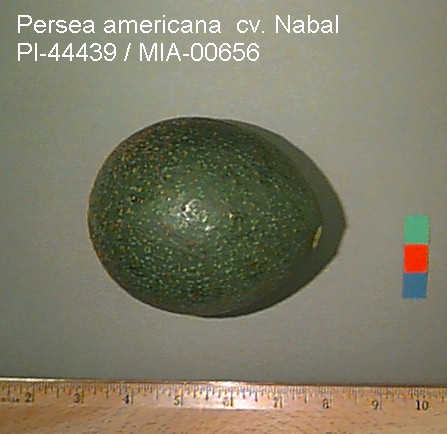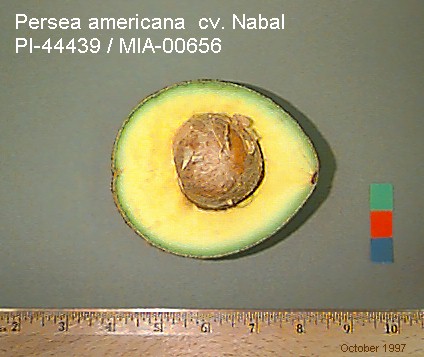Avocados were introduced to what is now Israel in 1908, but the named cultivars 'Fuerte' and 'Dickinson' were not brought in for trial before 1924. In 1934, 'Benik', 'Nabal' and 'Queen' were imported from California. By 1947, 'Fuerte' was the leading commercial cultivar, but because of irregular bearing a more dependable cultivar was sought. Other cultivars under trial at that time were 'Duke', 'Northrup', 'Mexicola', 'Ganter', 'Puebla', 'Caliente' and 'Anaheim'. 'Hass' was introduced into Israel in the late 1940s and was added to the list of recommended varieties by the mid-sixties (Ohad, 1965; Ticho and Gefen, 1965). 'Fuerte' continued to be the most commonly planted cultivar into the late 1970s (Gustafson, 1967), and remains important. In recent years, cultivars which developed within the country as well as some of California's newer cultivars have been planted in Israel. The subtropical Mediterranean climate in that part of the world is characterized by winter weather (November to mid-March) which is generally cool but may be as warm as 30°C on cloudless days. (Occasional temperatures of 40°C or above may occur during extremely hot "khamsin days" in springtime.) Freezing temperatures may rarely occur on the coastal plain, with temperatures in some pockets lacking air drainage having descended as low as -4.5°C (Oppenheimer, 1947). The success of Israel's avocado industry, based on germplasm from California, most of which came originally from Mexico, is exemplified by production figures over a 35-year period, rising from 800 metric tons (mt) in 1961 to 75,900 mt in 1996 (FAOSTAT database, 1999). Avocados are widely grown in South Africa, principally in the eastern and northern Transvaal and also in frost-free coastal belts of the Cape Province and Natal, as well as Swaziland (Malan, 1957). The climate for Nelspruit in the Transvaal is classified as Low Tierra Fria with a dry monsoon, suitable for wheat, maize, rice and cotton (Papadakis, 1966). Nelspruit is also a center of citrus production. In the 35 years from 1961 to 1996, South African avocado production increased by more than 10-fold, from 4,700 mt to 49,100 mt (FAOSTAT Database, 1999).

Persea americana 'Nabal' |

Persea americana 'Nabal' Half |
Chile has a variety of climates, among them subtropical semiarid Mediterranean and marine Mediterranean (Papadakis, 1966), which are well suited to avocado culture. Seedlings of Mexican race were known in the country from colonial times, but California commercial cultivars were first imported by the Ministry of Agriculture in 1928. Because of climatic problems where they were planted, in Santiago, they attracted little attention. In 1932, however, a shipment of 14 cultivars of Mexican, Guatemalan and hybrid origin was received and planted at La Cruz, Chile, followed by additional cultivars in a couple of other shipments. These formed the nucleus of a developing avocado industry. 'Hass' was imported in 1944. In 1958, all production was marketed within Chile, and prices were occasionally depressed when fruit supplies exceeded demand (Magdahl, 1958). By 1965, however, demand was good and the industry was growing (Schmidt, 1965). This trend continued and accelerated as Chile entered the export market; its avocado production rose from 8,000 mt in 1961 to 55,000 mt by 1996 (FAOSTAT Database, 1999).
Avocados are grown in a variety of locations in Australia along the eastern coast of the country (Schulz 1961), with climatic classifications ranging from humid subtropical through semi-hot semitropical, semi-Mediterranean subtropical, cool winter hot tropical and humid semi-hot tropical (Papadakis, 1966). Some of the earliest cultivar importations came from California to Queensland in 1933, and very few introductions from Florida are grown there (Zentmyer, 1965). The fruit was not well known within Australia for some years after the first introductions, but the arrival of American servicemen in 1942 established a demand for it, and demand within the country grew slowly in the years after World War II (Sharpe, 1950; Storey, 1960). By 1961 four main cultivars were grown: 'Hass', 'Fuerte' and 'Rincon', all imported from California, and a cultivar that originated in Australia, 'Sharwil' (Schulz, 1961). The increased popularity of the avocado in recent years is demonstrated by the fact that only 400 mt of fruit were produced in 1961, but production by 1996 had risen to 16,400 mt ( FAOSTAT Database, 1999).
Effect of Success of Antillean and Guatemalan-Antillean Hybrid Cultivars on Production Elsewhere, as Reflected in Exports of Germplasm
In the 65 years from 1933 to 1998, 179 distributions (one or more cultivars or seeds) of avocado germplasm were sent from USDA's clonal repository at Miami to much of the world including equatorial Africa, the Caribbean and tropical America, and various parts of Asia and Oceania (USDA 1933-98). Some distributions were in response to individual requests, and others were made in cooperation with various aid-oriented organizations. These distributions have without question been instrumental in the three-fold increase in world avocado production that came about in the 35 years from 1961 to 1996. There is no record of germplasm distributions from Miami to Cameroon, but that country's record is impressive; its avocado production increased from 12,000 mt in 1961 to 45,000 mt in 1996. The increase was less in Ghana, which produced 4,000 mt in 1961 and 6,300 mt in 1996. Production figures for Senegal are not available before 1991, when production was 16,000 mt, and increased to 20,000 mt by 1996. Obviously figures varied from one country to another, but the change in avocado production for Africa as a whole rose from 44,000 mt in 1961 to 204,000 mt in 1996. One Asian country that received germplasm from the USDA in Florida was the Philippines, where production rose from 13,300 mt in 1961 to 26,000 mt in 1996. The upward change for Asia as a whole during this period was from 44,200 mt in 1961 to 273,900 mt in 1996. (FAOSTAT Database, 1999) Looking at the total world, a dramatic increase in avocado production is apparent in the immediate past, from 696,900 mt in 1961 to 2,231,500 mt in 1996. This 3.2-fold increase was reached in large part by the transfer of germplasm from Mexico through California to parts of the world where Mediterranean-type climates predominate, and from the Caribbean and Guatemala through Florida to those areas which have warm lowland-type climates.
Literature Cited
Anonymous. 1946. George Beauregard Cellon 1862--1945. In Memoriam. California Avocado Society Yearrbook 1946:127.
Brooks, C. I. 1929. Avocados. Proceedings Florida State Horticulture Society 42:123- 129.
Court, A. 1974. The climate of the conterminous United States. In Climates of North America. R. A. Bryson and F. K. Hare, Eds. World Survey of Climatology,
Vol. II. Elsevier, Amsterdam-London-New York. 420 p.
Fairchild, D. 1939. Reminiscences of early avocado introductions. California Avocado Society Yearbook 1939:44-46
FAOSTAT Database, Food & Agricultural Organization. 1999. United Nations, Rome.
(Accessible on Internet at <http://apps.fao.org/lim500/nph-wrap.pl?Production.
Crops.Primary&Domain=SUA>)
Florida Avocado Administrative Committee, 1999. Shipping Schedule, 1999-2000 Season. Fla. Avocado Administrative Committee, Homestead, Florida
Gustafson, C. D. 1967. The avocado industry in Israel. California Avocado Society Yearbook 51:85-88.
Institute of Economics, University of Habana, Cuba. 1974. In Encyclopaedia Britannica Macropedia 5:349.
Magdahl, R. A. 1958. Report from Chile. California Avocado Society Yearbook 42:44- 52.
Malan, E. F. 1957. Avocados. In Handbook for Farmers in South Africa, Vol. 2, Agronomy and Horticulture. The Government Printer, Pretoria. 880 p.
Mosiño Alemán, P. A and García, E. 1974. The climate of Mexico. In Climates of North America. R. A. Bryson and F. K. Hare, Eds. World Survey of
Climatology, Vol. II. Elsevier, Amsterdam- London-New York 420 p.
Ohad, R. 1965. More on avocados in Israel. California Avocado Society Yearbook 49:61-66.
Oppenheimer, C. 1947. The avocado industry in Palestine. California Avocado Society Yearbook 1947:112-119.
Papadakis, J. 1966. Climates of the world and their agricultural potentialities. DAPCO, Rome. 174 p.
Popenoe, W. 1926. The parent Fuerte tree. Annual Report California Avocado Association 1925-26:23-24.
Popenoe, W. 1927. Manual of Tropical and Subtropical Fruits. Macmillan, New York and London.
Popenoe, W. 1934. Early history of the avocado. Californnia Avocado Association Yearbook 1934:106-110.
Schieber, E. and Zentmyer, G. 1980. The "Guatemalan Criollos." California Avocado Society Yearbook 64:85-90.
Schmidt, M. 1965. Avocado growing in Chile. California. Avocado Society Yearbook 49:45-46.
Schulz, G. H. 1961. The avocado in Queensland, Australia. California Avocado Society Yearbook 45:37-38.
Shamel, A. D. 1936. The parent Fuerte avocado tree. California Avocado Association. Yearbook 1936:86-92.
Sharpe, F. V. 1950. The avocado in Australia. California Avocado Society Yearbook 1950:124-125.
Smith, C. E., Jr. 1966. Archaeological evidence for selection in avocado. Economic Botany 20:169-175.
Smith, C. E. 1969. Additional notes on pre-conquest avocados in Mexico. Economic Botany 23:135-140.
Storey, W. B. 1960. The avocado in Australia. California Avocado Society Yearbook 44:66-71.
Ticho, R. J. and Gefen, B. 1965. The avocado in Israel. California Avocado Society Yearbook 49: 55-60.
Wolfe, H. S., Toy, L. R. and Stahl, A. L.
(G. D. Ruehle, revised). 1949. Avocado production in Florida. Bulletin
141, Agricultural Extension Service. Gainesville, Florida